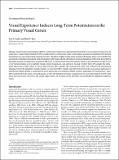| dc.contributor.author | Cooke, Samuel Frazer | |
| dc.contributor.author | Bear, Mark | |
| dc.date.accessioned | 2012-02-28T17:33:32Z | |
| dc.date.available | 2012-02-28T17:33:32Z | |
| dc.date.issued | 2010-12 | |
| dc.date.submitted | 2009-09 | |
| dc.identifier.issn | 0270-6474 | |
| dc.identifier.issn | 1529-2401 | |
| dc.identifier.uri | http://hdl.handle.net/1721.1/69230 | |
| dc.description.abstract | Stimulus-specific response potentiation (SRP) is a robust form of experience-dependent plasticity that occurs in primary visual cortex. In awake mice, visual evoked potentials (VEPs) recorded in layer 4 of binocular visual cortex undergo increases in amplitude with repeated presentation of a sinusoidal grating stimulus over days. This effect is highly specific to the experienced stimulus. Here, we test whether the mechanisms of thalamocortical long-term potentiation (LTP), induced with a theta burst electrical stimulation (TBS) of the dorsal lateral geniculate nucleus, are sufficient to account for SRP. First, we demonstrate that LTP similarly enhances the amplitude of VEPs, but in a way that generalizes across multiple stimuli, spatial frequencies, and contrasts. Second, we show that LTP occludes the subsequent expression of SRP. Third, we reveal that previous SRP occludes TBS-induced LTP of the VEP evoked by the experienced stimulus, but not by unfamiliar stimuli. Finally, we show that SRP is rapidly and selectively reversed by local cortical infusion of a peptide that inhibits PKMζ, a constitutively active kinase known to maintain NMDA receptor-dependent LTP and memory. Thus, SRP is expressed by the same core mechanisms as LTP. SRP therefore provides a simple assay to assess the integrity of LTP in the intact nervous system. Moreover, the results suggest that LTP of visual cortex, like SRP, can potentially be exploited to improve vision. | en_US |
| dc.description.sponsorship | Howard Hughes Medical Institute | en_US |
| dc.description.sponsorship | National Institutes of Health (U.S.) | en_US |
| dc.description.sponsorship | National Eye Institute (Grant R01 EY018323-01) | en_US |
| dc.language.iso | en_US | |
| dc.publisher | Society for Neuroscience | en_US |
| dc.relation.isversionof | http://dx.doi.org/10.1523/JNEUROSCI.4333-10.2010 | en_US |
| dc.rights | Article is made available in accordance with the publisher's policy and may be subject to US copyright law. Please refer to the publisher's site for terms of use. | en_US |
| dc.source | SFN | en_US |
| dc.title | Visual Experience Induces Long-Term Potentiation in the Primary Visual Cortex | en_US |
| dc.type | Article | en_US |
| dc.identifier.citation | Cooke, Sam F., and Mark F. Bear. “Visual Experience Induces Long-Term Potentiation in the Primary Visual Cortex.” Journal of Neuroscience 30.48 (2010): 16304–16313. | en_US |
| dc.contributor.department | Massachusetts Institute of Technology. Department of Brain and Cognitive Sciences | en_US |
| dc.contributor.department | Picower Institute for Learning and Memory | en_US |
| dc.contributor.approver | Bear, Mark | |
| dc.contributor.mitauthor | Bear, Mark | |
| dc.contributor.mitauthor | Cooke, Samuel Frazer | |
| dc.relation.journal | Journal of Neuroscience | en_US |
| dc.eprint.version | Final published version | en_US |
| dc.type.uri | http://purl.org/eprint/type/JournalArticle | en_US |
| eprint.status | http://purl.org/eprint/status/PeerReviewed | en_US |
| dspace.orderedauthors | Cooke, S. F.; Bear, M. F. | en |
| mit.license | PUBLISHER_POLICY | en_US |
| mit.metadata.status | Complete | |
